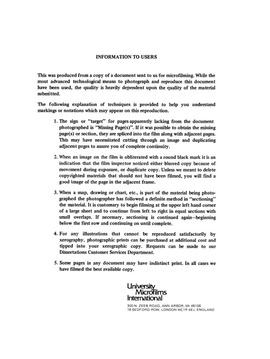| dc.contributor.author | Feaver, John Hansen, | en_US |
| dc.date.accessioned | 2013-08-16T12:28:04Z | |
| dc.date.available | 2013-08-16T12:28:04Z | |
| dc.date.issued | 1980 | en_US |
| dc.identifier.uri | https://hdl.handle.net/11244/4735 | |
| dc.description.abstract | Over the past several years the release of many new government documents made it necessary to take another look at the question. The initial intent in undertaking a survey of these documents was to determine more precisely to what degree and in what ways domestic public opinion influenced the decisions of the Truman Administration toward China after World War II. As research progressed, however, it became clear that at no time in the period from the end of World War II to the beginning of the war in Korea did decision makers seriously entertain the option of cutting off American support to Chiang and the Nationalist regime and for reasons which had virtually no direct relationship to public opinion. As a matter of necessity, therefore, the study began to shift away from being concerned primarily with the question of the effect of public opinion and toward the general problem of identifying, to the extent possible, the full range of those factors involved in the Administration's formulation of its China policy. | en_US |
| dc.description.abstract | Until fairly recently, existing interpretations of United States policy toward China in the period between 1945 and 1950 contended that some form of public opinion and congressional pressure constituted important, even decisive, factors in the Truman Administration's formulation of that policy. And, prior to the availability of documents bearing on the subject, the most compelling assessment in this regard argued that strong American public sympathy for Chiang Kai-shek in general, and his congressional backers in particular, forced the Truman Administration to continue to aid the Nationalist government after 1946 despite the Administration's better judgment and policy preferences to withdraw support from what it considered to be a losing cause. This view further proclaimed that in 1949 and 1950 Chiang's American supporters kept the Administration from severing its ties with the Nationalists on Formosa as a necessary prerequisite to the official desire to recognize the newly formed Chinese Peoples Republic on the mainland. | en_US |
| dc.description.abstract | The study begins with a survey of the essentials of United States wartime policy toward China after 1943. It starts here because decisions made in the last two years of the war go a long way toward explaining the Truman Administration's commitment to assist in resolving China's internal problems in the immediate aftermath of the conflict. Subsequent to this initial commitment, the basic contention of this study is that, for military and strategic reasons arising out of the concern about Soviet expansionism, the Truman Administration never seriously considered withdrawing from China prior to the Korean War. | en_US |
| dc.description.abstract | The study terminates with the beginning of the Korean conflict despite the fact that increasing numbers of previously classified documents concerning China are now open for all of 1950 and 1951. This is because Korea appeared to confirm Administration officials in their earlier decisions, again based on military and strategic considerations, to support the rump Nationalist government on Formosa and to refrain from recognizing the newly established Communist regime in Peking. The North Korean attack, in sum, eliminated flexibility and set in place the basic elements of American policy toward China for the following two decades. | en_US |
| dc.format.extent | ii, 577 leaves ; | en_US |
| dc.subject | History, United States. | en_US |
| dc.title | The Truman Administration and China, 1945-1950 : | en_US |
| dc.type | Thesis | en_US |
| dc.thesis.degree | Ph.D. | en_US |
| dc.thesis.degreeDiscipline | Department of History | en_US |
| dc.note | Source: Dissertation Abstracts International, Volume: 41-03, Section: A, page: 1186. | en_US |
| ou.identifier | (UMI)AAI8019124 | en_US |
| ou.group | College of Arts and Sciences::Department of History | |
